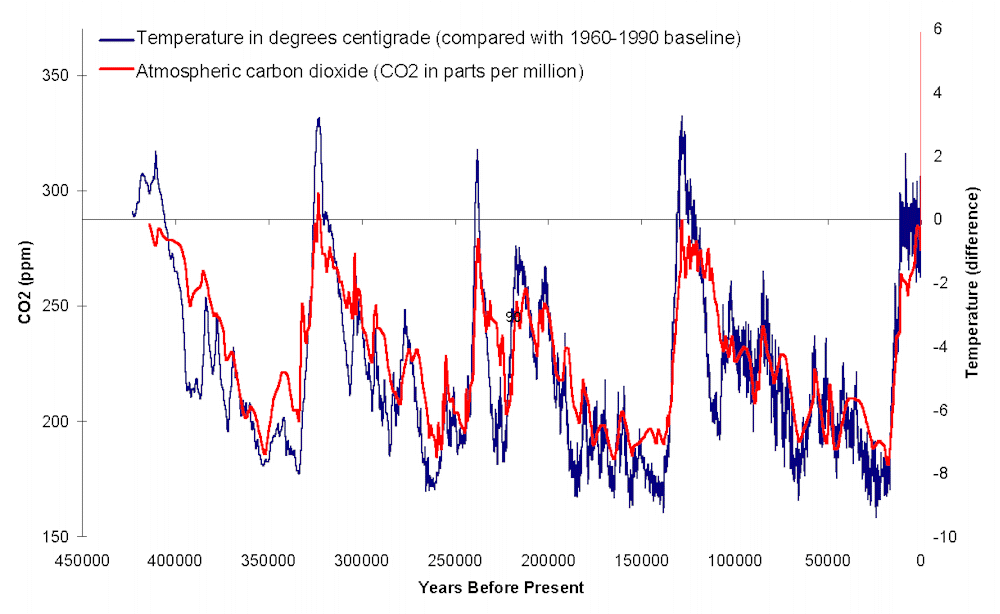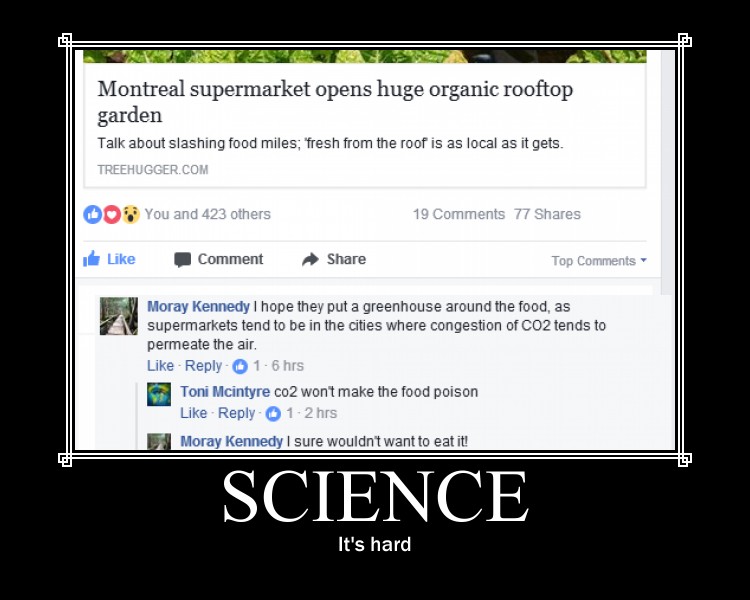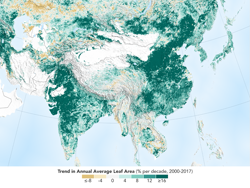|
Research into Carbon Storage in Arctic Tundra Reveals Unexpected Insight into Ecosystem Resiliency
May 16, 2013 "We hypothesize that net soil carbon hasn't changed after 20 years because warming-accelerated decomposition has been offset by increased carbon inputs to the soil due to a combination of increased plant growth and changing soil conditions,"
|
"The precipitous decline in atmospheric CO2 levels ~ 30 million years ago"
Evolutionary trajectories, accessibility, and other metaphors: the case of C4 and CAM photosynthesis
Erika J Edwards, Department of Ecology and Evolutionary Biology, Yale University, 165 Prospect St, New Haven CT 06520-8105, USA
"C4 photosynthesis and Crassulacean Acid Metabolism(CAM)are two alterations of the plant primary metabolism, and present two ofthemorestriking examples massive convergence in plants. The precipitous decline in atmospheric CO2 levels ~30 million years ago presented a global selection pressure on terrestrial photosynthesis(Edwardsetal.,2010).Atlow CO2 and high temperatures, photosynthesis becomes inefficient due increased levels of photorespiration. Land plants(primarily angiosperms)responded en masse, by evolving—well over 100 times — C4 and CAM photosynthesis(Fig1).
Today, C4 and CAM plants play fundamental ecological role in the terrestrial biosphere, with C4 plants contributing up to ~23% of global primary productivity and CAM plants dominating vast areas of the arid landscape(Stilletal.,2003; Ogburn & Edwards, 2010).
|
The demonized chemical compound is a boon to plant life and has little correlation with global temperature.
The cessation of observed global warming for the past decade or so has shown how exaggerated NASA's and most other computer predictions of human-caused warming have been—and how little correlation warming has with concentrations of atmospheric carbon dioxide. As many scientists have pointed out, variations in global temperature correlate much better with solar activity and with complicated cycles of the oceans and atmosphere. There isn't the slightest evidence that more carbon dioxide has caused more extreme weather.
|
CO2 stopped rising. Nobody noticed this?
Co2 hasn't risen in years. Next time read it's still rising, check the date. If it's ten years old then it's almost certain all of the information on that site is out of date and not accurate.
NASA has already begun putting up disclaimers on some of its older data: "Disclaimer: This material is being kept online for historical purposes. Though accurate at the time of publication, it is no longer being updated. The page outdated information".
Outdated information like: "CO2 is rising".
|
Fungi pull carbon into northern forest soils Organisms living on tree roots do lion’s share of sequestering carbon
"The study’s findings could help global carbon modelers tweak their simulations, says climatologist Victor Brovkin of the Max Planck Institute for Meteorology in Hamburg. “How to model soil carbon is poorly understood,” he says."
“That’s why this new evidence is important to us. But scientists have not understood where exactly trees put their carbon. The issue becomes important when researchers build computer simulations that track carbon cycling."
"Settled science" is not "poorly understood".
|
Over the last two decades, the Earth has seen an increase in foliage around the planet
January 2019
The world is literally a greener place than it was 20 years ago, and data from NASA satellites has revealed a counterintuitive source for much of this new foliage: China and India. A new study shows that the two emerging countries with the world’s biggest populations are leading the increase in greening on land. The effect stems mainly from ambitious tree planting programs in China and intensive agriculture in both countries.
The greening phenomenon was first detected using satellite data in the mid-1990s by Ranga Myneni of Boston University and colleagues, but they did not know whether human activity was one of its chief, direct causes. This new insight was made possible by a nearly 20-year-long data record from a NASA instrument orbiting the Earth on two satellites. It’s called the Moderate Resolution Imaging Spectroradiometer, or MODIS, and its high-resolution data provides very accurate information, helping researchers work out details of what’s happening with Earth’s vegetation, down to the level of 500 meters, or about 1,600 feet, on the ground.
|
Positive environmental effects of carbon dioxide
This study looks at the positive environmental effects of carbon dioxide (CO2) emissions, a topic which has been well established in the scientific literature but which is far too often ignored in the current discussions about climate change policy. All life is carbon based and the primary source of this carbon is the CO2 in the global atmosphere. As recently as 18,000 years ago, at the height of the most recent major glaciation, CO2 dipped to its lowest level in recorded history at 180 ppm, low enough to stunt plant growth.
This is only 30 ppm above a level that would result in the death of plants due to CO2 starvation. It is calculated that if the decline in CO2 levels were to continue at the same rate as it has over the past 140 million years, life on Earth would begin to die as soon as two million years from now and would slowly perish almost entirely as carbon continued to be lost to the deep ocean sediments. The combustion of fossil fuels for energy to power human civilization has reversed the downward trend in CO2 and promises to bring it back to levels that are likely to foster a considerable increase in the growth rate and biomass of plants, including food crops and trees. Human emissions of CO2 have restored a balance to the global carbon cycle, thereby ensuring the long-term continuation of life on Earth.
(RJS - I take great exception with the last line, the case has not been made for this)
|
Temperature forces CO2, not vice versa
Temperature, among other factors, drives atmospheric CO2 much more than CO2 drives temperature. The rate of change dCO2/dt varies ~contemporaneously with temperature, which reflects the fact that the water cycle and the CO2 cycle are both driven primarily by changes in global temperatures (actually energy flux – Veizer et al).
|
Evidence of variability of atmospheric CO2 concentration during the 20th century
Since the 19th century, use of chemical methods has provided reliable atmospheric CO2 gas analyses
results that have been obtained predominantly from the northern hemisphere. These direct chemical
analyses results provide information on past atmospheric CO2 concentrations in addition to the
modern direct atmospheric CO2 measurements since 1958 and the indirect reconstructions of past
atmospheric CO2 from ice cores. Comprehensive literature indicates that the chemical methods have
provided a systematic accuracy within ± 3 Vol% since 1857. Optimization through the 20th century
resulted in numerous sampling round the world on land and sea resulting in systematic sampling and
analysis of more than 90,000 CO2 values near ground, sea surface and up to the stratosphere when
around 1960 the modern NDIR spectroscopic method was introduced. Comparison of measurements
using old wet chemical and new physical methods in 1958 and 1967 on sea and land reveal a
systematic analysis difference of about 10 ppm - new procedures compared to the old. Wet chemical
analyses indicate that during the past 2 centuries there were three atmospheric CO2 maxima in the
northern hemisphere. These maxima were as high as about 400 ppm in average over land and sea.
The chemical analysis results indicate that atmospheric CO2 concentration – including its peak around
1942 – has about 80% correlation with the arctic sea surface temperature (SST) during the 20th
century. Detailed analysis of CO2, weather and oceanographic data during the arctic warming since
1918 to 1939 indicate a strong warming of the Northern Arctic Ocean with a subsequent decrease of
CO2 absorption in distinct absorption hotspots (e.g. near Spitsbergen) as a cause of the increased
decadal atmospheric CO2 levels that is not seen in the ice core records.
|
CO2 not well mixed in atmosphere - distorts measurements.
Originally designed to measure atmospheric water vapor and temperature profiles for weather forecasting, AIRS data now allow scientists to map the global distribution of mid-tropospheric carbon dioxide and its seasonal and interannual variation. AIRS data have shown that carbon dioxide is not well mixed in the atmosphere and that its transport around the globe is greatly influenced by the mid-latitude jet streams. The AIRS data have also discovered a belt of mid-tropospheric air containing enhanced concentrations of carbon dioxide, appearing most strongly between 30 and 40 degrees south latitude during the southern hemisphere winter season. This belt had not previously been seen in any chemistry transport model and has only recently been confirmed via in situ aircraft measurements. The process by which this belt arises is not yet understood.
|
|
|
|
As the earth heats up trees use more CO2
Study at woods hole showed that as the earth heats up trees use more CO2.
|
Contribution of natural sources of CO
Contribution of natural sources of CO2 - Salby.
|
Warming raises CO2, not the other way around: the evidence
On August 2, 2011 Professor Murry Salby, Chair of Climate Science at Macquarie University in Australia with visiting professorships at Paris, Stockholm, Jerusalem, and Kyoto, made a presentation entitled Global Emission of Carbon Dioxide: The Contribution from Natural Sources showing that changes in atmospheric CO2 levels appear to be primarily related to natural temperature changes, not human CO2 emissions.
|
|
"The maximum potential loss of O2 from fuel burning, when fossil fuel reserves (mostly coal) are exhausted is only a few percent of the atmospheric burden. Since even this loss will take many centuries to materialize, it's hard to see this as high on the list of possible environmental concerns. Fossil-fuel burning causes much larger relative changes in atmospheric CO2, which is much less abundant in air than O2."
A few *percent" ? Percent? CO2 rises by ppm and is "much less abundant" but o2 can go down a few percent and it's not an issue. Pffft.
|
Forests soak up third of fossil fuel emissions: study
"If you were to stop deforestation tomorrow, the world's established and regrowing forests would remove half of fossil fuel emissions," he told AFP, describing the findings as both "incredible" and "unexpected".
|
Viruses from Space, Fred Hoyle
"The question of survivability of terrestrial type microorganisms in alien environments is not new. Seckbach and Libbey (Space Life 2, 1971, 121> exposed algae that simulated the atmosphere of Venus, CO2 at 50% and at a prsure of 50 Atmospheres in acid.
The green algae Scenedesaus sp. produced larger cells and had higher activity in the simulated environment than the laboratory control. Cyanobacter caldarum a thermiphilic/acidophilic aglae collected from the acid suphate springs at Yellowstoe National Park thrived greatly in the simulated Cytherian atmosphere. It also produced larger cells than the control.
|
Small 'hot spot' responsible for producing the largest concentration of the greenhouse gas methane seen over the United States
|
|
|



